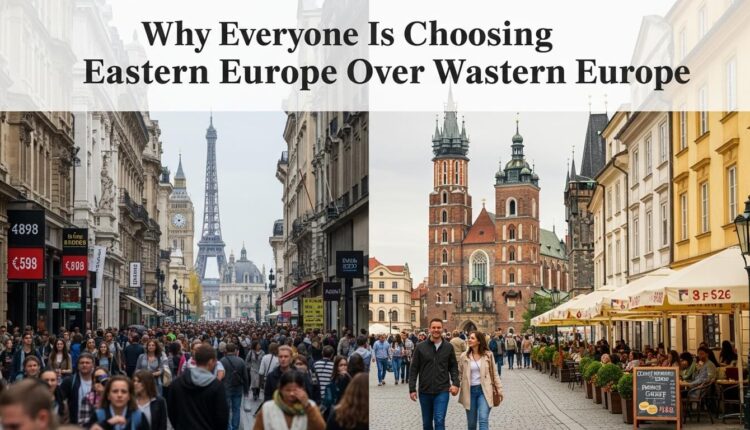Why Everyone Is Choosing Eastern Europe Over Western Europe
Why Everyone Is Choosing Eastern Europe Over Western Europe? For decades, Western Europe has carried the crown as the ultimate dream destination for international students. Parisian boulevards, the academic halls of Oxford, and Berlin’s buzzing cultural life have long defined what many believed to be the “gold standard” of studying abroad. Yet, beneath this glossy exterior lies a truth that more and more students are confronting: Western Europe comes with a staggering price tag, intense competition, and growing lifestyle challenges.
The high tuition fees, the overwhelming cost of living, and the struggle to secure housing in cities like London, Paris, or Amsterdam are creating serious roadblocks. According to Eurostat (2024), the average monthly rent in London has soared past €2,000, while in Paris, students spend nearly 50% of their monthly budget on accommodation alone. Tuition fees can easily range between €10,000–€20,000 per year for non-EU international students in Western Europe. For many, this dream of studying in the West is slowly transforming into financial stress, debt burdens, and even burnout.
Now here’s where the shift is happening. While students in Western Europe are stretching their wallets to the limit, a growing number of international students are turning their gaze eastward — to Prague, Warsaw, Budapest, Bucharest, and beyond. These cities in Eastern Europe are offering not just affordable education, but globally recognized degrees, a lower cost of living, and an immersive cultural experience that many Western destinations can no longer provide.
The narrative is changing, and quickly. According to UNESCO’s Global Student Mobility Report (2024), international student enrollments in Eastern Europe have grown by over 35% in the past five years, with Poland, Czech Republic, and Hungary emerging as the region’s top destinations. This surge is not a coincidence. It’s a result of students realizing that Eastern Europe combines academic quality, cultural richness, and affordability in ways Western Europe struggles to match.
Imagine saving €10,000 a year in tuition while living in a historic city like Kraków, enjoying vibrant nightlife, and graduating with a degree recognized across Europe and beyond.
This is why thousands of students are already making the switch. They’re no longer just following tradition — they’re choosing strategically. And yet, many still hold on to outdated stereotypes that Eastern Europe lags behind. Those who fail to look beyond the surface risk missing out on a life-changing opportunity that is becoming one of the smartest study-abroad decisions in 2025.
Why This Matters for You
If you’re planning to study abroad, the question is not just where do you want to live? but also what kind of life do you want to afford while studying? In a world where education costs are soaring, Eastern Europe has become the hidden gem — affordable, safe, and academically competitive. The longer students wait to explore these opportunities, the more they risk locking themselves into financial and emotional struggles that could have been avoided.
Eastern Europe is no longer the “underdog” of study-abroad destinations. It is the emerging powerhouse that offers what many students now crave: high-quality education at a fraction of the cost, vibrant student communities, and a lifestyle that doesn’t compromise.
In this guide, we’ll dive into the data, comparisons, and stories that explain why more students are choosing Eastern Europe over Western Europe — and why you might want to, too.
Data-Backed Comparisons
When considering where to study abroad, emotion and excitement often come first — but data doesn’t lie. Numbers reveal why Eastern Europe is increasingly winning the attention of international students over its Western counterparts. Let’s look at three key areas where Eastern Europe is proving itself: cost of living & tuition fees, education quality, and student lifestyle & safety.
2.1 Cost of Living & Tuition Fees
Perhaps the single most influential factor for international students is cost. Tuition and living expenses in Western Europe can quickly become overwhelming, especially for students coming from non-EU countries.
- In France, international students from outside the EU pay an average of €2,770 per year for undergraduates and €3,770 for master’s programs. While this may sound affordable, it is offset by the sky-high living expenses in Paris, Lyon, or Bordeaux.
- In the UK, tuition fees average between £10,000 and £20,000 per year for international students, with London rents soaring to £1,500–£2,000 per month.
- Compare this with Poland, where tuition averages €2,000–€5,000 per year and students in Warsaw or Kraków can live comfortably on €800–€1,200 per month.
Quick Snapshot Comparison
| Factor | Eastern Europe (Avg.) | Western Europe (Avg.) |
| Tuition Fees | €2,000 – €5,000/year | €10,000 – €20,000/year |
| Rent (1-Bedroom City) | €400 – €700/month | €1,200 – €2,000/month |
| Monthly Living Costs | €800 – €1,200 | €2,000 – €3,500 |
This cost gap is life-changing. Imagine completing a three-year degree in Budapest and spending less than one year’s tuition in London. The affordability of Eastern Europe is not just attractive — it’s transformative.
2.2 Education Quality & Global Recognition
Affordability is just one piece of the puzzle. Many students worry that lower costs mean lower quality. However, Eastern European universities are proving that affordability and excellence can coexist.
- Charles University (Czech Republic) – consistently ranks among the top 300 universities globally in the QS World University Rankings.
- University of Warsaw (Poland) – a leader in research and international partnerships, particularly strong in IT and humanities.
- Jagiellonian University (Poland) – one of Europe’s oldest universities, ranked in the top 500 globally, especially recognized in medicine and sciences.
- Eötvös Loránd University (Hungary) – respected worldwide for liberal arts, sciences, and research.
According to the QS World University Rankings 2024, at least 30 universities in Eastern Europe made it into the global top 1,000 — a sign of growing recognition. Many now offer English-taught programs in medicine, engineering, IT, and business, eliminating the language barrier that once discouraged international students.
2.3 Student Lifestyle & Safety Factors
Life outside the classroom matters just as much as academics. Students want safety, affordability, and social opportunities. Here, too, Eastern Europe scores strongly.
- Safety: According to the Global Peace Index (2024), countries like Slovenia, Czech Republic, and Hungary rank higher for safety than several Western capitals. For example, Ljubljana (Slovenia) is considered one of Europe’s safest capitals for students.
- Affordability of lifestyle: Dining out in Kraków can cost less than €10, while in Paris the same experience may be €25–€30. Public transport passes in Budapest average €30/month, compared to €80–€100 in London or Berlin.
- Vibrant student communities: Eastern Europe is part of the Erasmus+ program, which promotes student exchanges across Europe. This has made cities like Prague, Warsaw, and Budapest hubs for international networking and cultural exchange.
The numbers show a clear picture: Eastern Europe is not just about saving money — it’s about living well while studying well.
Why This Comparison Matters
Students are no longer swayed by prestige alone. They want education that is affordable, recognized, and practical. They want to live in a safe city, travel easily across Europe, and enjoy student life without constant financial stress. In these areas, Eastern Europe is proving it can compete head-to-head — and often win — against Western Europe.
Unique Advantages of Eastern Europe
It’s one thing to say Eastern Europe is cheaper — but if affordability were the only factor, students could choose countless other destinations around the world. What makes Eastern Europe special is that it combines low costs with unique cultural, social, and academic advantages that can’t be easily replicated elsewhere. For many students, this mix turns a “practical choice” into an exciting and life-changing study-abroad experience.
Let’s explore these unique advantages.
3.1 Authentic Cultural Experiences
Western Europe, with its famous landmarks and crowded capitals, often feels like a tourist postcard. Eastern Europe, on the other hand, offers a chance to experience authentic European culture without the overwhelming commercialization.
- In Kraków, Poland, students walk through medieval streets, study in centuries-old libraries, and enjoy lively student nights in underground cafés — all while living in a city where history is part of daily life.
- In Tallinn, Estonia, the old town blends fairytale-like cobblestone streets with a thriving digital society, making it both historic and futuristic.
- In Romania, traditions like folk festivals, rural village visits, and authentic cuisine give international students a glimpse into cultural heritage that still thrives in everyday life.
These are not just Instagram moments — they are immersive cultural journeys. Students aren’t just studying; they’re living history in cities that have shaped Europe for centuries.
3.2 Smaller, Less Crowded Cities with Strong Student Communities
In contrast to the overwhelming hustle of London or Paris, many Eastern European cities are more student-centered and approachable.
- Warsaw and Budapest are large enough to offer vibrant nightlife, international airports, and diverse job markets, but small enough to maintain a sense of community.
- Universities like Masaryk University (Czech Republic) and Vilnius University (Lithuania) are famous for their welcoming international student networks.
- Students often comment on how easy it is to make friends in Eastern Europe, as the smaller class sizes and strong local traditions naturally encourage bonding.
This sense of belonging can be critical for international students navigating homesickness or cultural adjustment.
3.3 Emerging Job and Internship Opportunities
Eastern Europe is not just a place to study — it’s a place to launch a career. Over the past decade, the region has become a magnet for investment and innovation:
- Tech Hubs: Cities like Tallinn (Estonia), Vilnius (Lithuania), and Warsaw (Poland) are gaining recognition as Europe’s “Silicon Valleys.” Startups in fintech, cybersecurity, and AI are flourishing.
- Multinational Expansion: Companies such as IBM, Microsoft, Amazon, and Google have expanded their operations in Budapest, Warsaw, and Bucharest, creating opportunities for internships and post-graduation employment.
- EU Recognition: Degrees from Eastern European universities are recognized across the European Union, which means graduates can easily pursue careers elsewhere in Europe if they choose.
For international students, this means studying in Eastern Europe is not just about affordability, but also about positioning themselves in emerging markets with strong future potential.
3.4 Student Testimonials and Real-Life Stories
The numbers are compelling, but stories make it real. Here are a few snapshots:
- Anita, from Nigeria, studying Medicine in Hungary: “I chose Budapest because tuition fees were half of what I would have paid in Western Europe. The facilities are excellent, my professors are supportive, and I’ve made friends from all over the world. I don’t feel like I’m missing out — in fact, I feel I’ve gained more than I expected.”
- Rahul, from India, studying Computer Science in Poland: “Warsaw has become my second home. It’s affordable, safe, and the tech scene is booming. I already secured an internship with an international IT firm here, something I never thought would happen so quickly.”
- Maria, from Brazil, studying International Relations in the Czech Republic: “Living in Prague is like living in a fairy tale. But beyond the beauty, I’ve gained valuable academic exposure. My courses are in English, and I’ve traveled to five European countries within my first year on a student budget.”
These real-life accounts show that Eastern Europe is not just a “cheap alternative” — it’s an experience that delivers academic, personal, and professional growth.
Why These Advantages Matter
Studying abroad is about more than just academics. It’s about personal growth, cultural immersion, and building a future. Eastern Europe offers:
- Rich traditions with modern opportunities.
- Affordability with quality.
- Small communities with global connections.
This rare balance is what makes students feel that Eastern Europe is not just a good choice, but in many cases, the best choice.
Addressing Misconceptions
For many students (and even their parents), Eastern Europe often comes with a certain set of stereotypes: it’s less modern, less safe, and less globally connected than Western Europe. These misconceptions have persisted for decades, largely shaped by outdated narratives from the Cold War era or old travel accounts. But in 2025, these assumptions no longer hold up to scrutiny. Let’s dismantle the myths with facts, data, and lived experiences from international students who have chosen Eastern Europe.
Myth #1: “Eastern Europe is behind in infrastructure and technology.”
- Reality Check: Many Eastern European cities such as Tallinn, Warsaw, and Prague are leaders in tech innovation, digital banking, and startup ecosystems. Estonia, for example, is recognized as one of the most digitally advanced countries in the world, offering e-residency programs and seamless online government services.
- Global Recognition: Universities in Eastern Europe are integrating cutting-edge technology into classrooms, offering programs in AI, robotics, and cybersecurity that rival their Western counterparts. Students often gain access to modern labs, international research projects, and innovation hubs at a fraction of Western tuition costs.
Myth #2: “Eastern Europe is unsafe for international students.”
- Reality Check: Safety indexes consistently show Eastern Europe competing strongly with — and often outperforming — Western Europe in student safety.
- Poland, Czech Republic, and Slovenia regularly rank among the safest countries in Europe.
- Crime rates in smaller Eastern European student cities are typically much lower than in big Western capitals like London, Paris, or Berlin.
- Student-Friendly Atmosphere: Universities in Budapest, Krakow, and Vilnius have dedicated international student offices, peer networks, and even city-sponsored programs to help newcomers integrate smoothly into the local community.
Myth #3: “There aren’t enough English-taught programs in Eastern Europe.”
- Reality Check: Over the last 15 years, Eastern Europe has seen a massive expansion of English-language study programs, particularly in fields like medicine, engineering, IT, and business.
- Hungary, Poland, and the Czech Republic each offer hundreds of full-degree programs taught entirely in English.
- International students can now complete full Bachelor’s, Master’s, or even PhD degrees without needing to master the local language (though picking up some phrases enriches the experience).
- Student Testimonial Example: An Indian medical student in Budapest explains, “I was surprised by how many international classmates I had — from Germany, Nigeria, and even the U.S. We all take our courses in English, and the teaching quality is world-class.”
Myth #4: “Eastern European degrees don’t have global recognition.”
- Reality Check: Many universities in Eastern Europe are part of the Bologna Process, ensuring their degrees are recognized across the European Union and beyond.
- Charles University in Prague, Jagiellonian University in Krakow, and Sofia University in Bulgaria are all over 600 years old and internationally respected.
- Fields like medicine, dentistry, and IT are especially strong, with graduates successfully practicing and working worldwide.
Why These Misconceptions Persist
The hesitation often comes from “perception lag” — Western Europe has long been branded as the gold standard for study abroad, while Eastern Europe is still carving out its identity in the global education market. But as more international students share their positive experiences, word-of-mouth is quickly rewriting the narrative.
For a student sitting on the fence — torn between following the traditional dream of studying in London or choosing a new path in Warsaw — this section is crucial. It takes their fears, acknowledges them, and directly disproves them with credible information. The message becomes clear: Eastern Europe is not a fallback option; it’s a first-choice destination.
Action-Oriented Conclusion (Call-to-Action)
By now, it’s clear that Eastern Europe is no longer the “hidden gem” of global education — it’s a front-runner. Affordable tuition, low cost of living, modern infrastructure, globally recognized degrees, and vibrant student communities make it one of the most compelling choices for international students in 2025.
But here’s the critical point: opportunity waits for no one. Thousands of students from Africa, Asia, and even Western Europe are already applying to universities in cities like Budapest, Krakow, and Prague. They’re securing scholarships, landing part-time jobs, and building international networks — all while avoiding the crushing debt that often comes with studying in London, Paris, or Berlin.
If you delay, you risk missing out on admission spots, scholarship deadlines, and affordable housing options that disappear quickly as application season progresses.
Next Steps for Students Ready to Explore Eastern Europe
- Research Universities and Programs
- Start with top-ranked institutions in Poland, Hungary, the Czech Republic, and Romania.
- Use platforms like QS World University Rankings or StudyAbroad.com to filter English-taught programs in your field.
- Check Visa and Residence Requirements
- Most Eastern European countries are part of the Schengen Area, making travel across Europe seamless.
- Visa processes are often faster and less restrictive than in Western Europe — a significant advantage for non-EU students.
- Explore Scholarships and Financial Aid
- Many Eastern European universities offer scholarships specifically for international students.
- Government-funded programs (like Poland’s Banach Scholarship Programme or Hungary’s Stipendium Hungaricum) cover tuition, housing, and even monthly stipends.
- Prepare for Cultural Integration
- Learn a few phrases in the local language — even simple greetings go a long way.
- Join student forums, Facebook groups, or WhatsApp communities where international students share housing tips and social events.
- Apply Early and Stay Ahead
- Deadlines for fall intake often close months in advance. Apply early to secure your place before spots fill up.
- Housing in popular student cities like Warsaw and Budapest is affordable but competitive — the sooner you apply, the better your options.
Final Thought
Western Europe may still carry prestige, but the reality of 2025 is that Eastern Europe offers a smarter, more affordable, and equally rewarding study abroad experience. The question isn’t “Why Eastern Europe?” anymore — it’s “Why not?”
So, if you’ve ever dreamed of studying abroad without drowning in debt, exploring beautiful cities without being lost in crowds, and earning a degree that opens doors worldwide — Eastern Europe is waiting.
📌 Don’t let outdated stereotypes hold you back. The sooner you act, the sooner you’ll join thousands of students already thriving in Eastern Europe.


